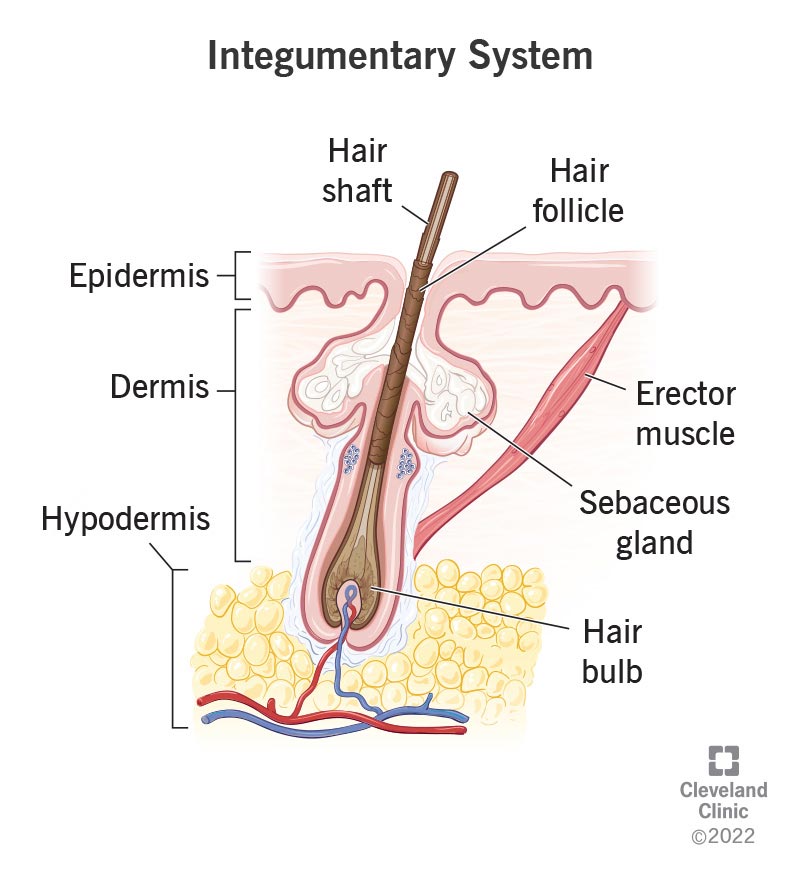Your integumentary system is your body’s outer layer. It consists of your skin, hair, nails and glands. These organs and structures are your first line of defense against bacteria and help protect you from injury and sunlight. Your integumentary system works with other systems in your body to keep it in balance.
Advertisement
Cleveland Clinic is a non-profit academic medical center. Advertising on our site helps support our mission. We do not endorse non-Cleveland Clinic products or services. Policy

Your integumentary system is your body’s outer layer. It’s made up of your skin, nails, hair and the glands and nerves on your skin. Your integumentary system acts as a physical barrier — protecting your body from bacteria, infection, injury and sunlight. It also helps regulate your body temperature and allows you to feel skin sensations like hot and cold.
Advertisement
Cleveland Clinic is a non-profit academic medical center. Advertising on our site helps support our mission. We do not endorse non-Cleveland Clinic products or services. Policy
Your integumentary system is an organ that consists of a few main structures: skin, nails, hair and glands, along with the nerves and blood vessels that support them.
Your skin is the largest and heaviest organ in your body. It weighs about 6 pounds (or more) and is approximately 2 millimeters thick — thinner on sensitive areas like eyelids, and thicker on surfaces that take more stress, like the soles of your feet. One inch of your skin contains nearly 19 million cells.
Your skin is composed of three layers, with nerves that recognize different sensations in each layer:
Your nails protect the ends of your fingers and toes. The anatomy of your nail consists of:
Advertisement
Our hair does more than help us look nice. The hair on your head helps keep heat in your body. Your eyelashes and eyebrows help protect your eyes from dirt and water.
Your hair is made of a protein called keratin. Your hair consists of three parts: the shaft, follicle and bulb.
Goosebumps are caused by your integumentary system. We all have hair erector muscles connected to our hair follicles and skin. When it contracts, it makes your hair stand up. The “goosebumps” are what we see when these tiny muscles contract.
Glands are found throughout your skin. They release materials like water, salt or oil from under your skin to the surface of your skin. Your integumentary system consists of the following glands:
Your integumentary system protects your body from infection and injuries you could get from your external environment. It’s your body’s coat of armor and the first line of defense against viruses, bacteria and other microbes. It shields your body from harmful light and helps regulate your body temperature. Your integumentary system stores fat, water, glucose and vitamin D, and helps support your immune system to protect you from diseases.
Your integumentary system has many important functions. It:
Your body is like a complex machine. All of your organs, body parts and systems work together to keep everything in check and working as it should. Your integumentary system plays a role in helping other systems maintain their functions.
For example, it helps your immune system because it’s the first line of defense against bacteria and infection. It also sends white blood cells to injuries to begin the healing process.
Advertisement
Your integumentary system helps you absorb vitamin D, which acts as a hormone and is crucial to your bone health because it affects calcium absorption.
The tiny hairs in your nose help your respiratory system because they filter out dust and other particles before you inhale them into your lungs.
Your integumentary system is unique because most health conditions associated with it are visible. Unlike your internal organs, health conditions of your skin, hair and nails are typically external — meaning you and your healthcare provider can see them.
Some of the most common skin disorders are:
Hair loss is the most common condition that affects your hair. Some types of hair loss are temporary, while others are permanent. The most common types of hair loss include:
Advertisement
Other common conditions of hair that aren’t related to hair loss are:
Like the other structures of your integumentary system, your nails are always exposed. Nail issues can be caused by your shoes, poor hygiene or from using nail files or trimmers incorrectly. Some of the more common nail conditions are:
Some conditions of the sweat and sebaceous glands are:
Advertisement
Your integumentary system is your body’s first line of defense against bacteria, injury and outside elements like sunshine and rain. Your skin, and its structures all play an important role in maintaining balance with other systems in your body. Like other organs, you can have problems with your integumentary system like acne, hair loss or nail fungus. Your healthcare provider can help you keep your skin, hair and nails healthy.
Every day, people see your skin, hair and nails. At Cleveland Clinic, our expert and caring dermatology team will make sure they’re healthy and strong.

Last reviewed on 04/25/2022.
Learn more about the Health Library and our editorial process.